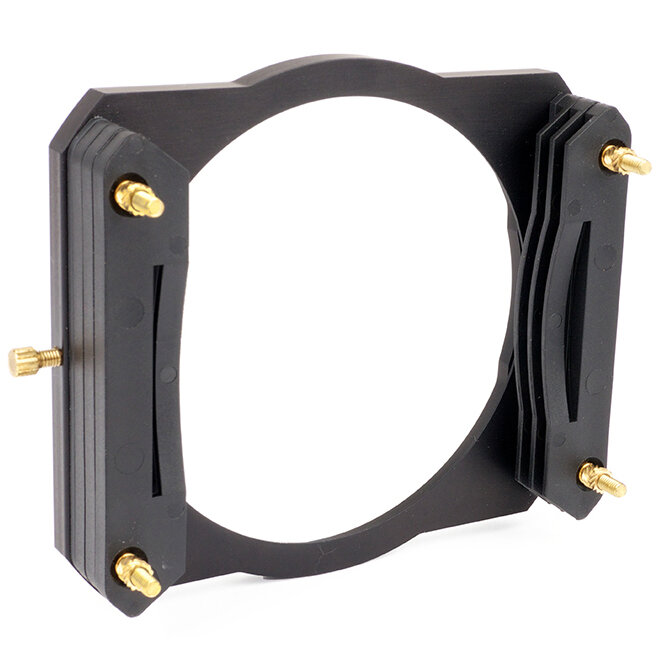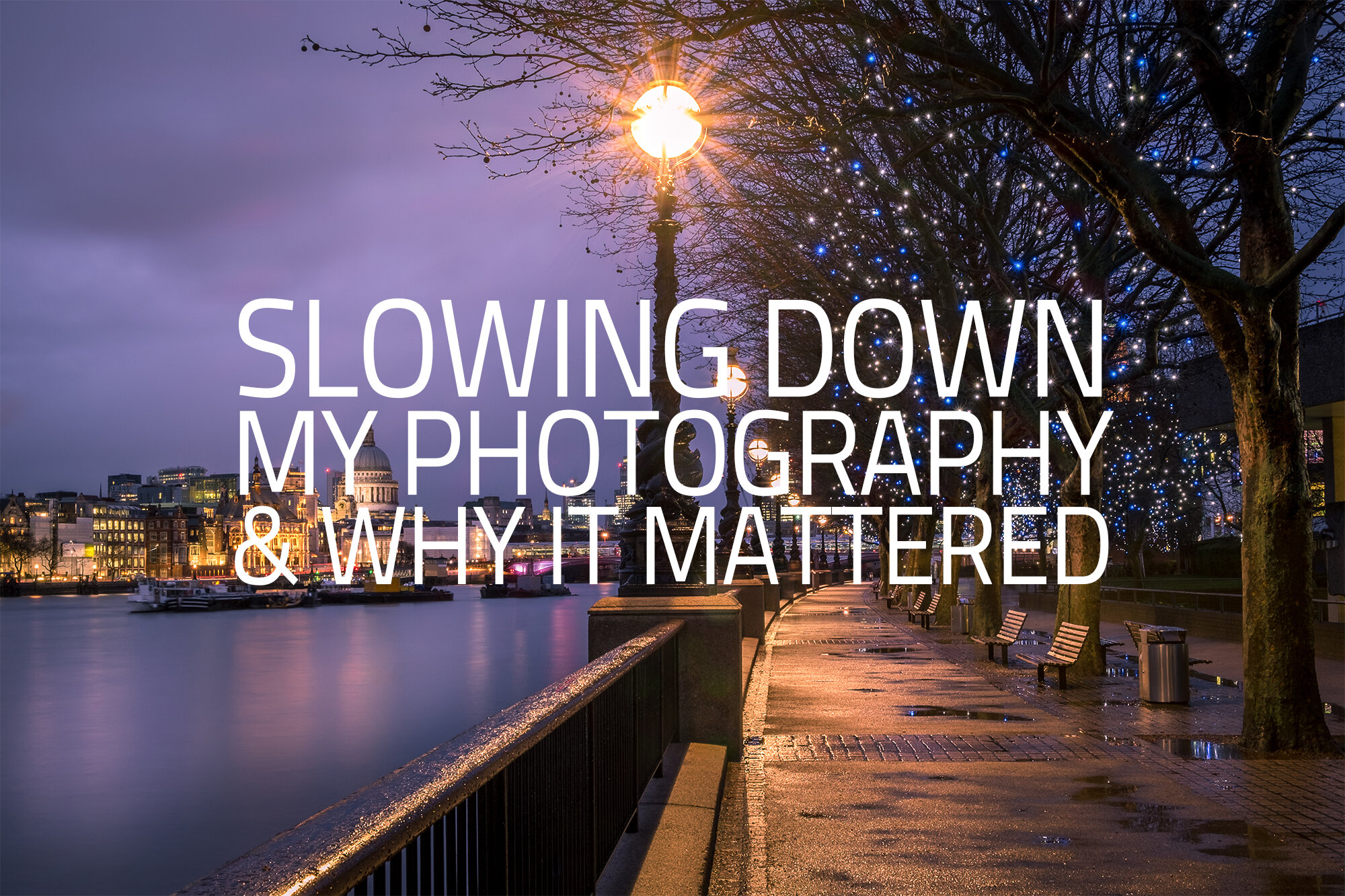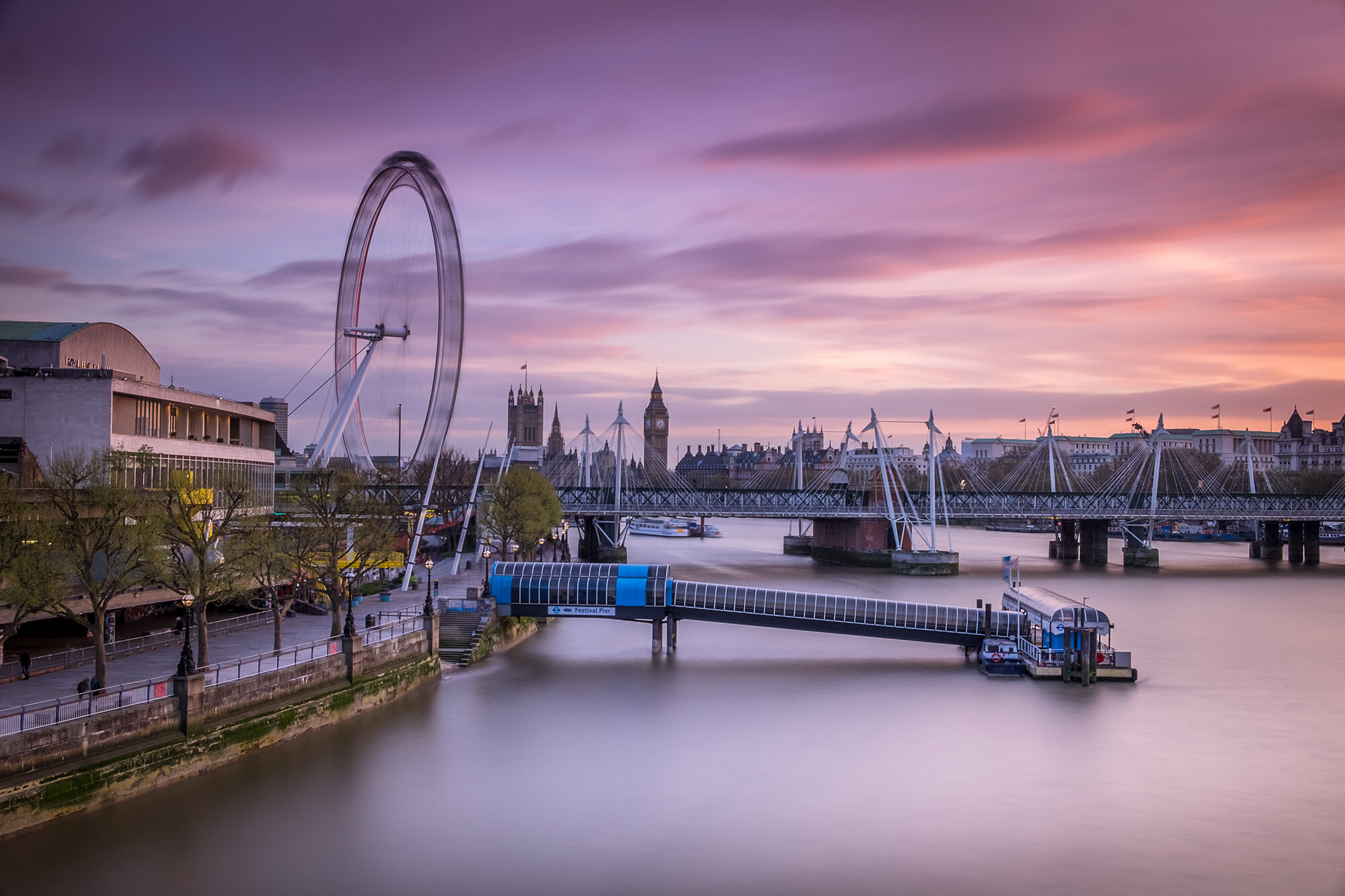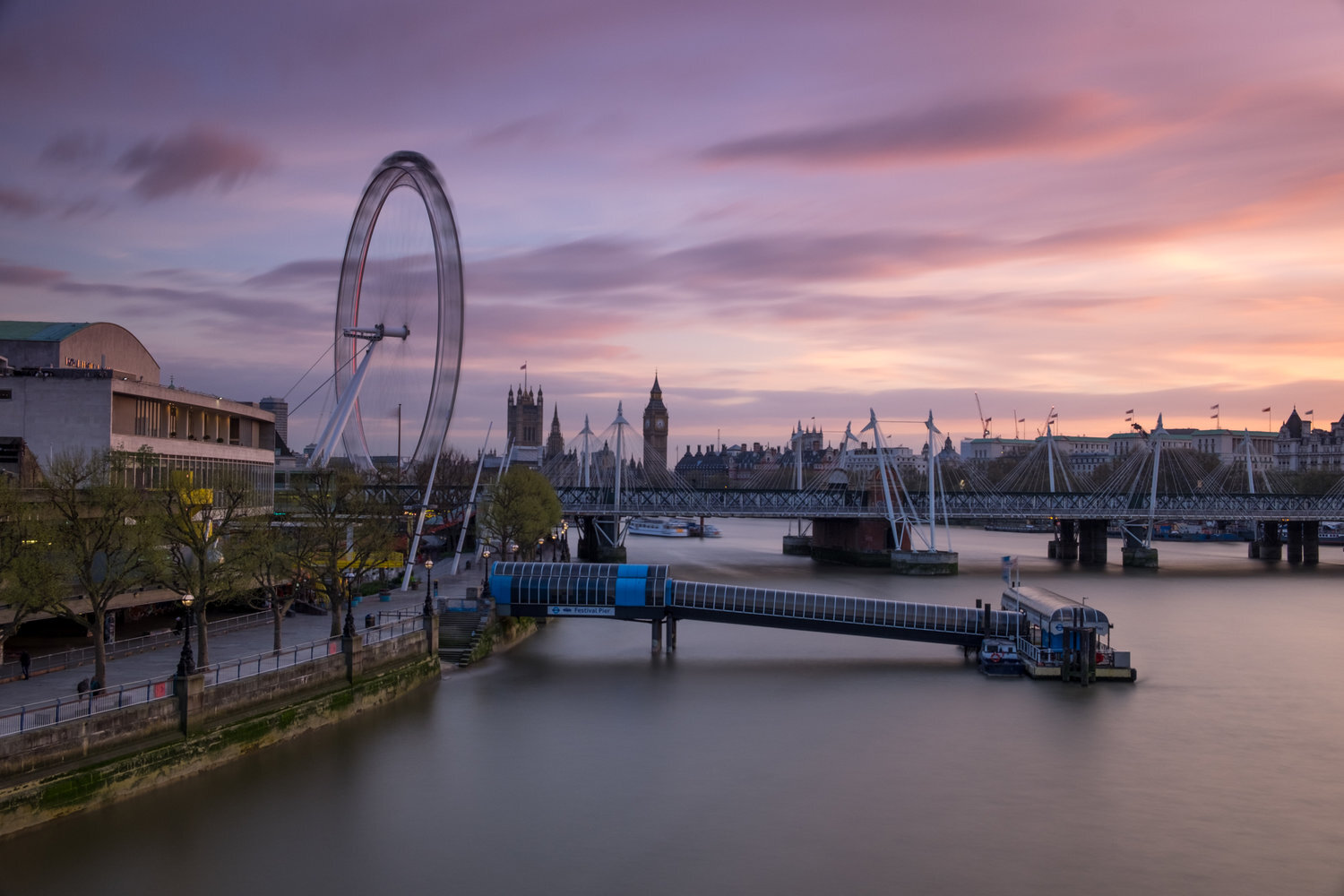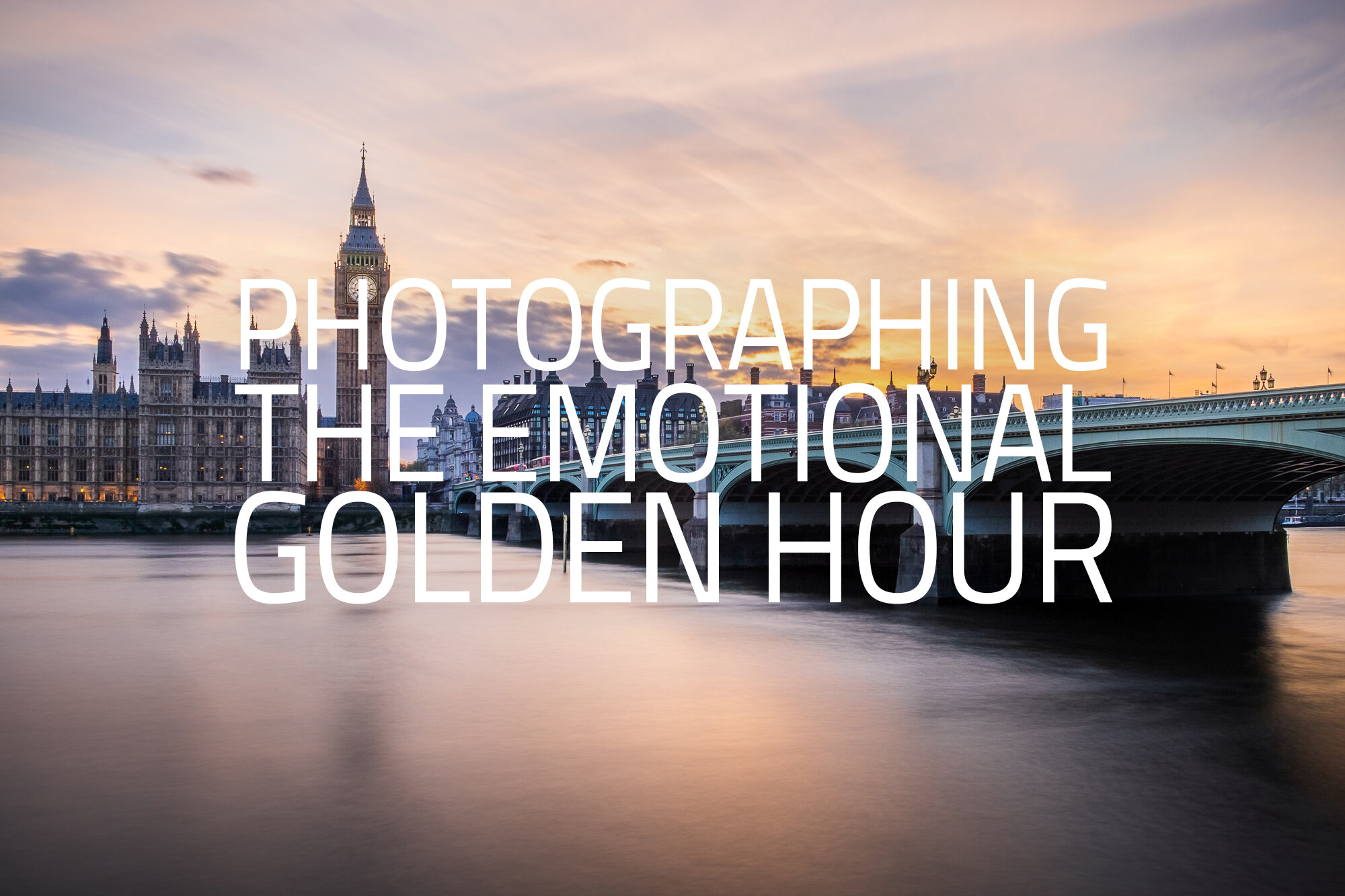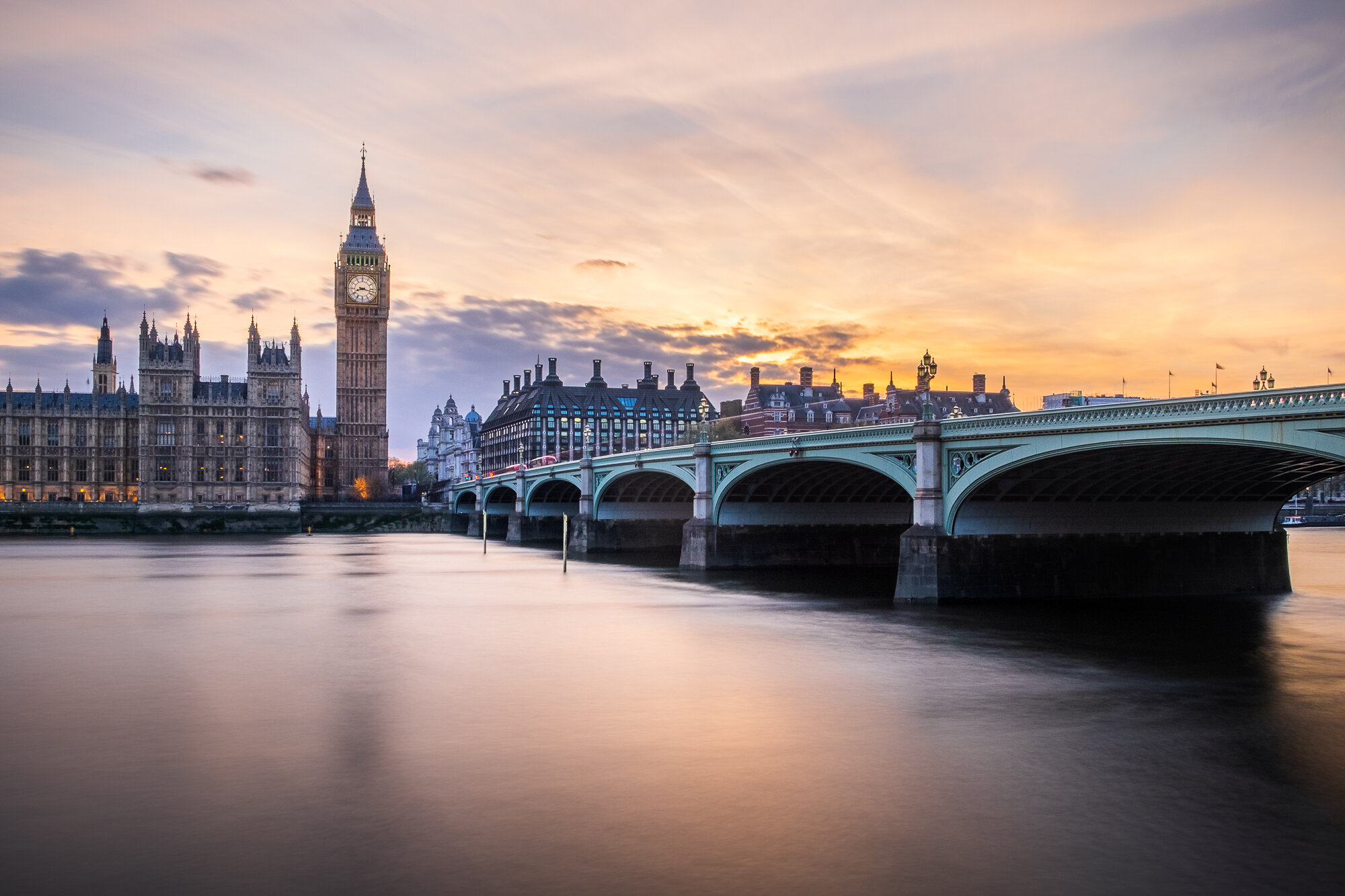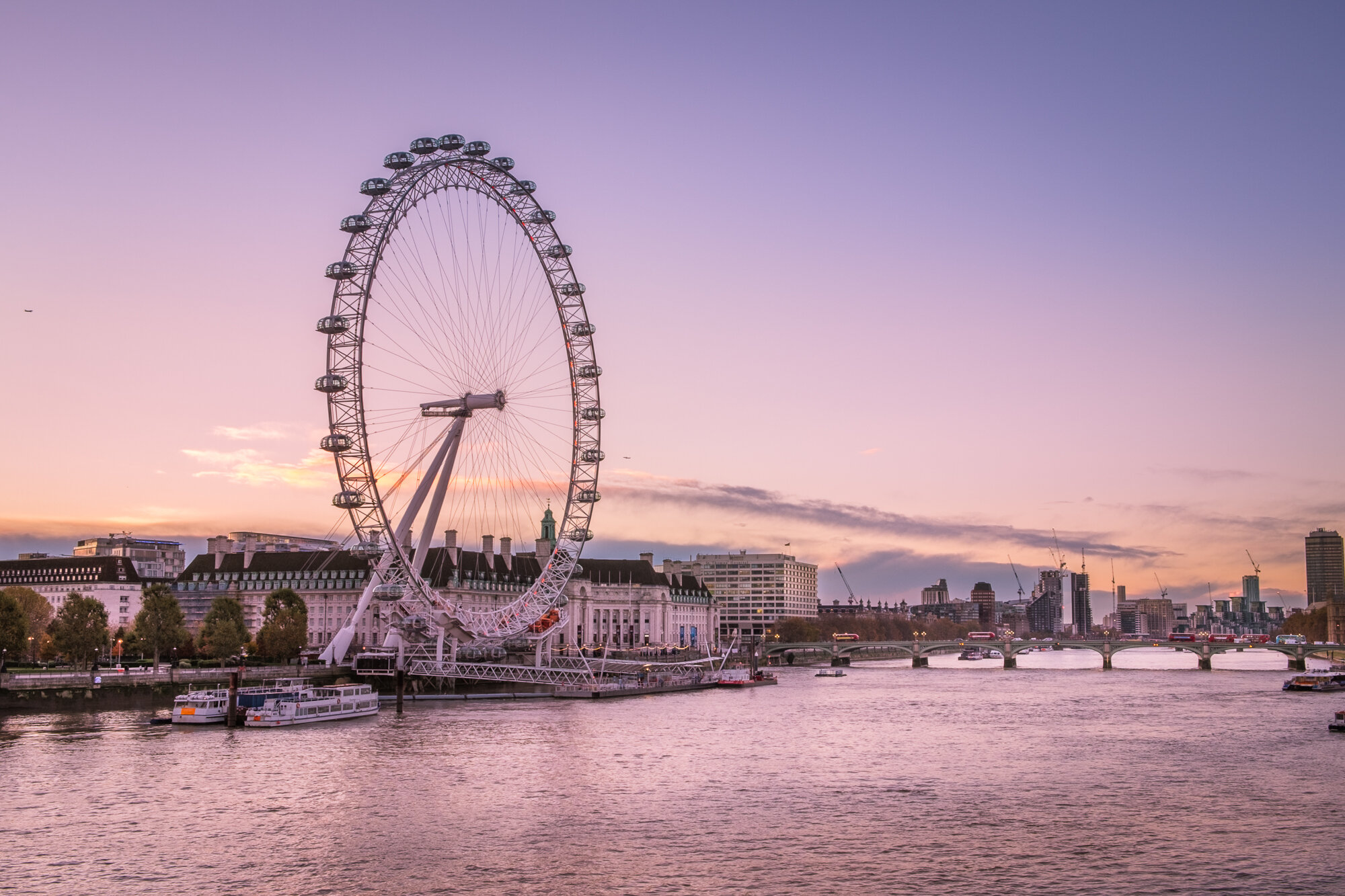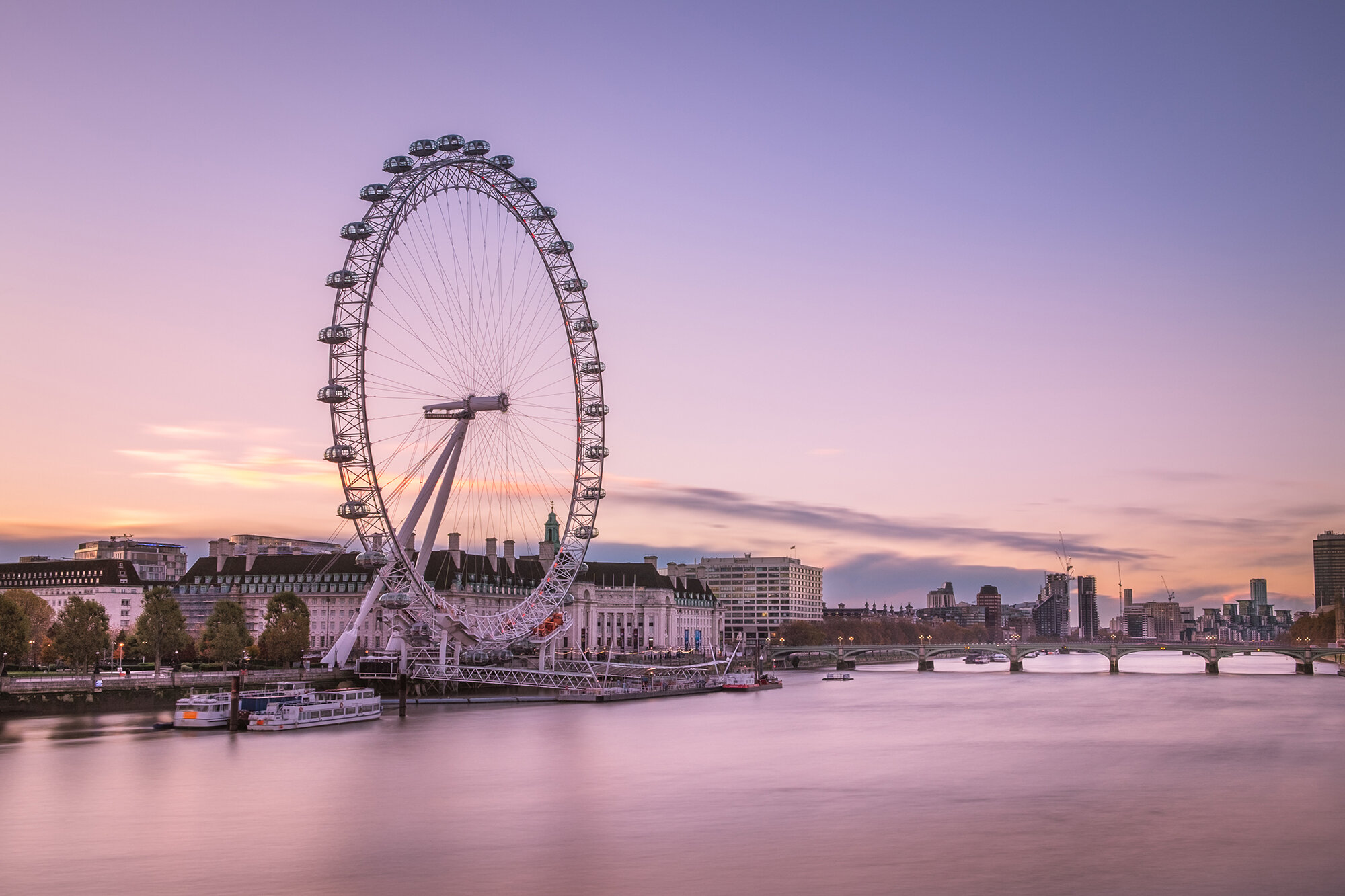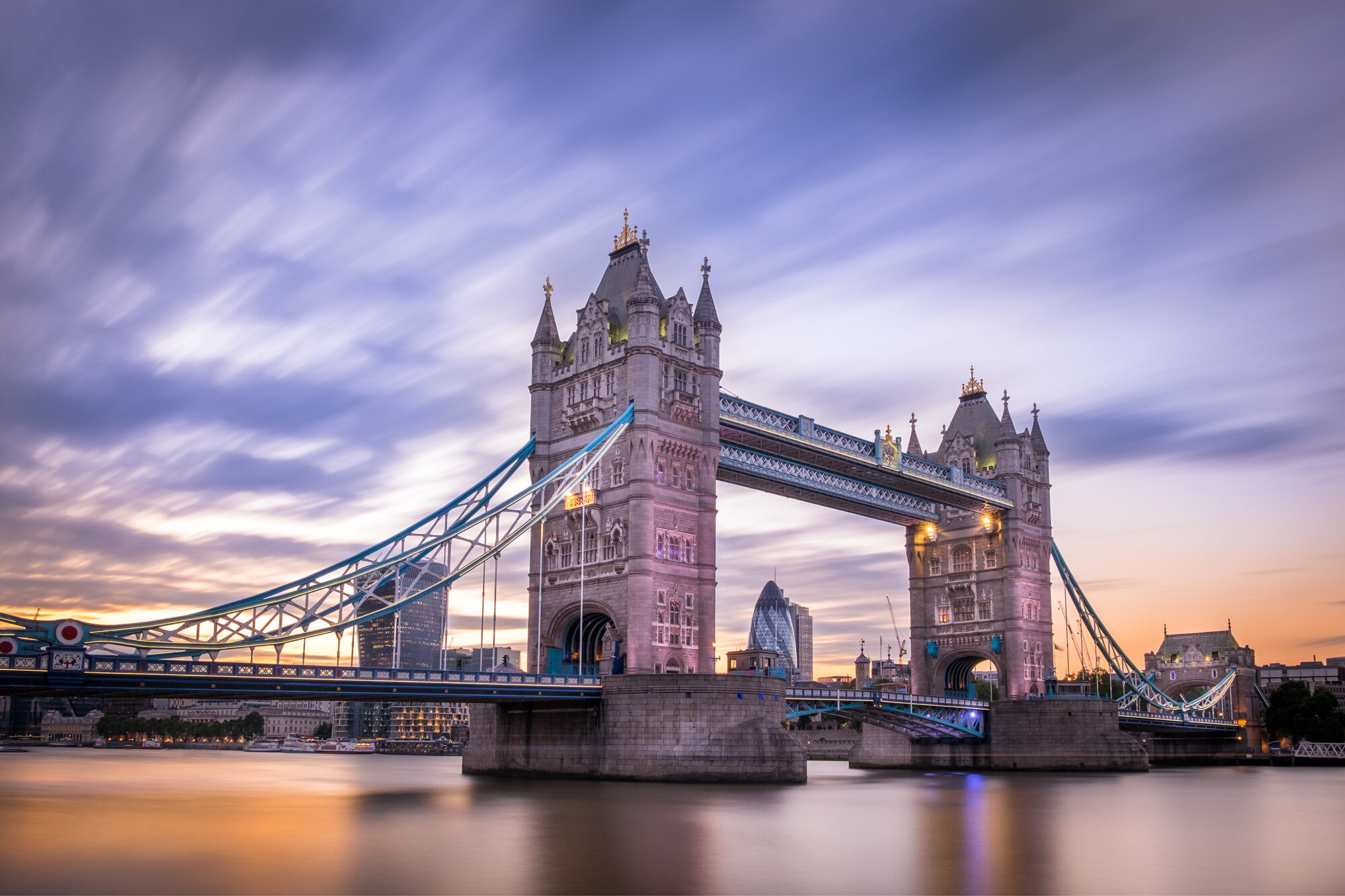BLOG ARCHIVE
How to take long exposure photos
How I take long exposure images. With my long exposure work getting a bit more attention, I am getting asked more often about how I take these images and what equipment I use. So I thought I would write this article to provide information about my tools and process while out in the field
With my long exposure work getting a bit more attention, I am getting asked more often about how I take these images and what equipment I use. So I thought I would write this article to provide information about my tools and process while out in the field.
I will start off by saying, I won't be covering the post-processing stage here. I recently wrote an article covering how I took a long exposure RAW image out of the camera to the final retouched photo which can be found here: Editing Sunset at the South Bank.
I will cover below what are, in my opinion, the three most important aspects to achieving successful long exposure photos which are the location/conditions, the equipment needed and technique but it should go without saying that practice and learning from your own experience is at least equal to and arguably more important than the information below. This post is just designed to provide someone enough information to get started with long exposure photography.
The right Location and Conditions
I explained in a previous post which can be found here that long exposure photography can be used as a compositional technique as the moving elements like clouds and water can create fantastic lead in lines or areas of interest.
Fujifilm X-T10 | XF18-55mm | 18mm | 90 Secs | f/16 | ISO200
So how does this relate to the location and conditions? The location is important as it can provide the moving elements for example, water along a river or by the coast. If the location does not lend itself to long exposures, the weather conditions, although less predictable can solve the problem by providing some moving clouds in the sky.
All of that being said, static subjects can be equally important and should not be forgotten, be it a bridge across a river or foreground interest in a landscape. Long exposure photography still requires a well-composed image.
Tip: Using websites or apps such as MeteoEarth or yr.no you can see what direction the wind and clouds are moving and the type of cloud cover. Armed with this information, you can pick your location specifically to ensure the clouds are moving towards or away from you rather than from side to side as this creates much stronger images when taking long exposures.
The Right Equipment
There are two areas that need particular focus when taking long exposure images. Firstly, the light. Long exposure images when there is still too much ambient light are only made possible by tricking the camera's light meter into thinking it is darker than it is so the camera opens the shutter for longer to let more light in. To achieve this, a neutral density filter can be placed in front of the lens to reduce the light hitting the sensor.
Currently, I am using the Formatt-Hitech 85mm filter system. More information can be found here. I use a filter system as it can be used with multiple lenses without the need to buy multiple filters. These systems are also ideal for using graduated filters when there is a need to balance a bright sky and a darker foreground.
The adapter ring shown here enables the filter holder above to be used with different lenses. All that is needed is the right adapter to fit the thread size on the lens. The size is measured in mm and can usually be found on the very front of the lens itself.
This is the neutral density (ND) filter itself to fit the holder above. I use a 10-stop filter that essentially reduces the light entering the lens and sensor by 10 stops. Here is an article to help understand what a "stop" is in relation to camera exposure.
Using one of the more professional kits in the industry, as shown above, can be expensive. If you are just starting out and want to dip your toe in the long exposure water then buying a screw in filter like this one is a great way to start as it can be a much more cost-effective option. Just be aware that you will need one of these for each of your lenses that have a different thread sizes.
Next up, is the second area to cover which is camera stability. When the shutter is open, it is imperative that the camera stays absolutely still. This is where a sturdy tripod comes in. I use the MeFOTO tripod below as it is light but strong and collapses down quite small which is useful as I walk around London. This isn't a recommendation as such but if you are shopping around for a mid-range, capable tripod, the MeFOTO range is worth checking out.
A cable release, as shown below is usually required once you start taking images above 30 seconds and need to switch the camera to its bulb mode. Regardless of exposure time, by using a cable release you avoid physically touching the camera when the image is taken so to avoid camera shake. In addition, when taking a long exposure in bulb mode, the cable release can be locked in place which means not having to hold the button down and makes the entire process much more comfortable for the photographer.
Tip: If using a cable release, I still tend to use a 2 or 10-second timer as this forces the camera to have just a little time to settle and any vibration stopped by the time the picture is taken. This is particularly useful when using a longer focal length as any vibration is exaggerated when fully zoomed in.
The Right Technique
So, you have found your location and readied your equipment. Your filter holder is on and cable release attached, then what now? You have to actually take the shot so below I will walk through the process I generally use to capture the image and expose it correctly.
Compose: Mount the camera on the tripod, compose the image and set the focal length when using a zoom lens.
Set Aperture: Set the desired aperture. When in doubt, start with around f10 but it really should be set based on the depth of field you need and the amount of ambient light available.
Focus: Set the focus, be it auto-focus or manual, this is the right time to do it as when the filter is attached, there may not be enough contrast for the camera to focus later. Make sure when the focus is set, set it to manual to prevent the camera trying to focus again when taking the shot.
Turn off IS: Some cameras will auto-detect being on a tripod, others won't. Whatever method works, make sure image stabilisation is turned off as the system may cause the image to be soft or blurry.
Capture exposure time: Without any filters attached and with the exposure time set to auto, take a test image and if exposed correctly, make a note of the exposure time the camera used e.g. 1/10th second.
Fit Filter: Whether you have a filter system or screw in filter, now is the time to attach the filter to your lens. Be careful not to move anything on the lens especially if using a zoom.
Calculate Exposure time: Using a long exposure conversion tool or app, calculate the correct exposure needed for the filter you intend to use. I use an app called "LE Calculator". With this app you can see what exposure time you need based on the filter you have the and exposure time you were provided by the camera. The image shows based on the 1/10th second exposure and using a 10-stop filter, I need to have an exposure time of 1m 42s.
Bulb Mode: Next you need to set you camera to bulb mode so you can control how long the camera shutter is open for.
Set timer: As I mentioned earlier, this part is optional but I usually set a 2 or 10 second timer just to force a small break into the process to allow the lens to settle just in case there is a tiny vibration from when I was setting up the camera. The camera has to be totally still!
Take image: Now, using the cable release, take the exposure for the time provided by the calculator tool you have used. When the time is up you should have a correctly exposed long exposure image. If your camera does not provide an on screen timer, you might want to ready your phone to measure the time.
The process above may look daunting at first and quite involved but with a little practice, it will become easier and you should end up doing some of these without thinking.
Tip: If taking long exposure images during sunrise or sunset, the light levels can change very quickly so your required exposure time may change while you are taking the shot itself. Experience will help here but be prepared to add a few seconds to the exposure if the light levels suddenly reduce or remove a few seconds if the light quickly increases.
Fujifilm X-T10 | XF18-55mm | 21mm | 280 Secs | f/9 | ISO200
So that's about it. I think I have captured the important points and I hope it provides some useful information for someone starting up with the long exposure technique. If I have forgotten anything, feel free to leave a comment and I will update the post.
Slowing Down My Photography And Why It Mattered
See how slowing down the three stages of my photography process has contributed hugely with helping me become a better landscape photographer.
When I first started to take photos in London (or pretty much anywhere), it would be a rather fast, disorganised ordeal from clicking away, taking hundreds of images around the city, to then getting back home, wading through and editing the images. I had no real plan or agenda when I would head out, there was no pre-meditated intention other than being there with my camera and the results certainly showed. I would occasionally take an "ok" photo but rarely would I take a photo I really liked such as the one below, taken more recently, which I would be happy to hang on my wall.
Fujifilm X-T10 | XF18-55mm | 26mm | 14 Secs | f/18 | ISO200
At the same time, all this was going on, I wasn't giving the right attention to the images I was taking. Nowadays I know I have a "keeper' the minute the shot is taken and I will be excited to get home and produce the final result. Way back when, I might not have even remembered the shots I'd taken and it wouldn't be until I viewed the images later that I would know if I had captured anything noteworthy.
Fast forward over ten years to today, and my photography is much calmer and deliberate. The photos I take are now more considered, pre-visualised and in nearly all cases, intentional.
Read on to see how slowing down the three stages of my photography process has contributed hugely to helping me become a better landscape photographer.
Stage 1: Planning the shoot
Before I head out to take photos, in most cases I will know exactly where I am headed and how long I need to get there. This might be because of previous scouting I've done or have used online tools such as Google Maps and other photography sites for inspiration such as 500px and Flickr.
Once I know the subject I intend to shoot I will check the right time to shoot with Suncalc.net. SunCalc will tell me what time the sun will rise and set on any given day as well as the angle of the sun at any time so I always know the best time of day or even time of year to capture the subject in great light. I will also use apps to check the weather such as MeteoEarth which will show me the expected cloud cover, wind direction or if rain is expected. Although with the famous English weather there are never any guarantees, with these tools I am able to increase the chances of coming away with a great shot of my chosen subject.
The important point to all of this planning is that if all goes to plan, I won't be rushing to get to a location and fumbling around trying to figure out a composition while missing the best light. The shoot should be calmer and more controlled allowing me to focus on taking the shot.
Stage 2: Taking the shot
It pays to find tools to help slow down your photography. One of the first tools I started to use was the trusty tripod. Tripods are a must for landscape/cityscape photography and having my camera attached to one of these automatically slows the picture taking process down as there is always an element of set-up to be done, adjusting the height, levelling the tripod head and so on.
In addition to the tripod, filters also help me slow down the process quite a bit, especially as I use a filter holder system which takes a little more setting up than the screw in kind. I use the system made by Formatt Hitech which I have found to be great to use with really high-quality filters. Popular amongst us landscape photographers, filters can be used to help balance the light in a scene or reduce the light for long exposure photography.
It is important to note that these tools can slow you down, but should not hinder you while in the field. Sometimes you need to act fast and being familiar with your tripod and filters can be the difference between catching a stunning shot with the best light or an average shot when the best light has disappeared. Having slowed down the process of capturing images, it allows me the time to focus on getting the right composition, the right light, removing distractions around the frame. Essentially getting as much of the finished image in camera as possible.
Stage 3: Post Processing the image
When I started to slow the process of taking photos down, one of the results was I now have far fewer images to process after the shoot. This is a good thing. I use Adobe Lightroom to for almost all of my processing but I rarely use presets so I edit from scratch for each image. Check out a recent post when I edited the Sunset at the South Bank image shown below.
With fewer images to edit and getting more right in camera, I spend less time overall editing photos. Don't get me wrong, I actually enjoy editing images, but I just don't have the time or patience to process through hundreds of them for each shoot.
Fujifilm X-T10 | XF18-55mm | 25mm | 58 Secs | f/11 | ISO200
So, there you have it, slowing things down allows me to head out to capture my chosen subject in good time, focus on the important things such as light and composition while capturing the shot and saves me time in the post-processing stage. All of these combined have resulted in my photography taking a huge leap forward from where it was before and I recommend it to anyone who might be looking for a way to progress further along their own photography journey.
6 Reasons to Photograph Close to Home
What may look familiar or even mundane to you may well look exotic to others. Here are 6 top reasons why you should spend more time exploring your local area and photograph around your home.
The romance and adventure of travel photography is the dream of many photographers. Travelling to far away places, recording the scenes and stories of the different landscapes or cultures will no doubt inspire, especially when visiting for the first time. Unfortunately, regularly experiencing travel photography is only feasible for some so in this post we will explore the benefits of the more accessible local photography. The familiar or even mundane may not immediately inspire those photographic juices in quite the same way as the new or glamorous locations we all see on social media, but remember, what's normal or mundane to you might well look exotic to those living in other parts of the world, you may just need to work a little harder to see past the familiar and find those subjects that inspire you. This post will run through 6 of the benefits I feel when photographing my local area.
One important point to note from the get-go is that it really doesn't matter what photography style you prefer, any photography enthusiast can read this post and use some, if not all of the information below.
What is local photography?
Let's face it, anywhere you might travel to away from home could technically be classed as travel photography so there is no single rule that determines what location would be classed as local. In the Australian outback, your next door neighbour could be tens of miles away making your local community larger than some small countries, where in New York City, you might consider just a few blocks to be local. There is, of course, no right or wrong answer here so decide what's best for you.
My take on it is that anywhere I can travel to within 35-40 minutes in the car is local. The surrounding towns, villages or countryside within this time are familiar and I know the area quite well.
So lets jump into my 6 reasons to photograph close to home.
Fujifilm X-T10 | XF10-24mm | 15mm | 30 Secs | f/16 | ISO200
The image above is called "End of the West Pier" and was taken in Brighton, East Sussex, UK and is on the limit of what I call "local" with it being a 40-minute drive from my home. This structure was called the West Pier and has suffered fire and storms since closing and just some of the metal structure remains. With the silhouette set against a simple backdrop, the detail in the structure really stands out so for this image only a long exposure would do.
#1 Removes a lot of the pressure
The thing about visiting somewhere new and for a limited time is that you may feel the pressure to capture that portfolio shot during your one and only visit. I know I certainly have. I've visited New York, Paris, Prague and so on and as these locations are exotic to me and have cityscapes and structures recognisable across the world, I could not help myself and attempted to capture the classic shots during my stay. Most of the photos I took were holiday snaps at best and rarely did I get a great shot. The thing is, unless you get really lucky, getting the best shots sometimes means visiting a location time and time again before all the elements come together such as weather, light, timing and so on. When shooting locally, this pressure to get it right on your first attempt is instantly removed as you don't have to get that shot and you can visit again and again until those elements come together for the shot you are trying to capture.
#2 You can find some hidden gems
This point is related somewhat to point one above. When you have the opportunity to visit a location multiple times (removing the pressure) and the portfolio shot is in the bag then the real exploring can begin. You start to see the hidden compositions and capture shots that you may not have seen before, documenting the location in new and innovative ways.
The shot below was taken at a place called Colley Hill in Surrey, UK. and was actually close to where I grew up. Now it is around a 20-minute drive from where I live. It took a number of visits to capture the shot I wanted of the moment the sun created this starburst effect as it dropped behind the hills. Capturing this image did not mean I stopped visiting. Since then I have started to explore the area further, trying to isolate subjects in the area and capture new compositions.
Fujifilm X-T10 | XF10-24mm | 10mm | 1/13th Sec | f/14 | ISO200
#3 It takes up less time
Let's face it, most of us who do not practice photography full time can only dedicate so much time to the craft and the further we travel, the less time we have available for actually taking pictures. Staying local means less travel and more photography. This means I don't have to dedicate an entire day or afternoon to a shoot. I will regularly pop out an hour or so before sunset and still be at the location with 45 minutes to scout the locations and set my shot up.
The benefit of not having to dedicate long periods to a shoot is that it makes the decision to go out a lot easier and I find that I get out more often. The positive side effect (aside from the fact that I am out with my camera, doing what I love) is that I am using my equipment more often. This helps me build up more equipment experience and muscle memory that allow me to focus more on the image and less on using my camera.
#4 You can have a lighter bag
When I travel, I have to think hard about what I take with me. The thought of missing that portfolio shot as I don't have the right equipment normally means I pack as much as I can sensibly carry. Local photography means there are a couple of alternatives to this approach. First, if on foot, how about just taking a camera and one or two lenses. With the pressure reduced and opportunities to return I can take less equipment with me which not only lightens the load but has the added benefit of allowing me to occasionally restrict myself to just the one lens during a shoot. It is widely known in the photography world that creating artificial restrictions can help a lot with the creative process as you learn to overcome these restrictions with different compositions or take images you might not have seen using another lens. Alternatively, shooting local for me usually means I have my car nearby so without fully committing to taking just the one lens I can leave some of my gear in the car, so it is nearby at least.
Fujifilm X-T10 | XF10-24mm | 10mm | 0.9 Secs | f/10 | ISO200
Taken on an early summer's evening, the shot above is about 25 minutes in the car from my home. This river runs along the base of Box Hill and these stepping stones cross the River Mole.
#5 You can explore and exploit your local area
There is something I enjoy about finding new places that I didn't know existed close to where I live. Although close to London, my immediate area isn't particularly well documented photographically so that leaves plenty of places to go and discover myself.
Bonus benefit alert! For those looking to make a bit of money from their photography, exploring and taking images of your local area can actually generate a revenue stream. You can look to attend local art and craft fares and sell mounted prints to local residents or sell images to small businesses such as coffee shops and cafes.
#6 It just gets you out there with the camera
Yes, this one seems a bit obvious but as mentioned previously, shooting locally can often mean less travel planning, logistics and time so with hurdles removed, getting out with the camera should come easier an as such something that can be done more often. Having a good hike around the area has it's obvious health benefits as it can get the heart beating and the blood flowing. The health benefits of anything you enjoy doing should be exploited wherever possible.
The picture below was taken only a few minutes from my home. It's just a tree in a field I drive past all the time. It was winter and I was drawn to the strong shape created by the bare tree on the horizon so one evening I just popped out, parked just behind where this image was shot from and spent 30-45 minutes taking the photo and headed back home.
Fujifilm X-T10 | XF18-55mm | 36mm | 1/30th Sec | f/7.1 | ISO200
There are, without doubt, more reasons or benefits to photographing your local area than the six I listed above but these were some of the benefits I think about and are important to me which really help with the motivation, let's face it, we all need some time to get out there and take photos.
Editing Sunset at the South Bank
Join me as I walk you through how I edited one of my favourite photos of 2017, Sunset at the South Bank. Starting with the RAW file and taking you all the way to the final image.
This post is not to open that can of worms amongst photographers about how much editing is too much editing. Everyone will have a different opinion and is why art is so subjective and this is a good thing and to be celebrated. It is clear, there is no right or wrong answer but I think it's apparent where I stand on the subject based on the images I produce but in case you were wondering, this is my take on it. I will edit my photos unapologetically but within limits I impose on myself to stay true to the scene I captured such as working with the shot that was taken and not substituting the sky or removing permanent objects that will significantly alter the scene I saw while on location. I will remove the occasional distracting temporary object such as cranes in a cityscape or a bird in the wrong place etc but this is on an image by image basis. I do blend images when required and the dynamic range is just too big for the camera to work with but anything I blend in was captured at that time and place and not somewhere else.
So now you know my values as a photographer, let me show you the journey of the Sunset at the South Bank image shown below, from the Fuji RAW file to the final image showing some of the steps the image took along the way.
Fujifilm X-T10 | XF18-55mm | 23mm | 58 Secs | f/11 | ISO200
I recently posted an "On Location" blog with the story behind this photo shoot in London which you can read here so I won't go into too much detail. Steps 1 to 5 below were performed in Adobe Lightroom and only the final sharpening step took place in Photoshop.
The raw image
So this is how the image started, taken straight out of the camera. As you can see, there is already a lot of reds and pinks in the sky and across the scene to exploit later in the final image.
A few settings for your information.
Camera: Fuji X-T10 with XF18-55mm lens
Exposure time: 58 seconds (10 stop natural density filter used)
Focal length: 23.3mm (zoom)
Aperture: F11 (the size of the hole that lets the light in)
ISO: 200 (lowest number, less light sensitive)
Step 1 - Levels and Vibrancy
In the image below, I have adjusted the levels (darks and lights) to help boost the image. Additionally I have added a touch of vibrancy to start exploiting those colours. I also slightly levelled the image.
Step 2 - Lights and Darks (Curves) and Vignette
In this image, i worked on the contrast of the shot, making the shadows a bit darker and lights a bit lighter which adds contrast and helps the image pop a bit more. Additionally, I added a bit of vignetting which I think helps frame the shot.
Step 3 - Graduated filter to boost the lower half
Next, I worked on boosting the water in the lower half of the image. I used a graduated filter and brightened up the water and added a touch of magenta to bring out the reflected colours from the sky.
Step 4 - Selecting lightening
Next, I did something I do to a lot of my images and is very subtle but very effective. It is a kind of dodge of burn technique. I will use a radial filter and selectively lighten areas to really make them pop in the image. In this image I added some more light and/or contrast to areas such as the South Bank river wall on the bottom right, the South Bank Centre to the left and the Festival Pier in the water. I also further lightened the water in the foreground.
Step 5 - Shadow colour and more selective lightening
In the penultimate image, I have added a subtle blue in the highlight and a touch of magenta in the shadows to really boost the colours in the image. I lightened areas of the water a bit more to help give it that smooth luxurious look.
Final Step - Sharpening and removing a few cranes
In the final image, I opened the image in Adobe Photoshop (all previous steps were in Adobe Lightroom). Beforehand, I had removed the default sharpening Lightroom applies and once in Photoshop, I used the high pass filter to apply some selective sharpening to the image. Finally, I cloned out a few cranes from the top of the buildings in the distance and the image creation process was complete.
Fujifilm X-T10 | XF18-55mm | 23mm | 58 Secs | f/11 | ISO200
I hope you found that somewhat useful. As I mentioned at the beginning of the post, I don't try to hide the fact that the post-processing is equally as important to me as the taking of the shot as I want the final image to look how I envisaged in my minds eye when at the location behind the camera absorbing the scene in front of me.
Photographing the Emotional Golden Hour
I often wonder what it is that draws us landscape photographers to the golden hour. What is it about the light at this time that makes us almost worship that great ball of fire in the sky. In this article, I discuss if there is something deeper than just contrasty scenes and pretty light.
Every day without fail, that golden, celestial ball of fire rises above the distant easterly horizon to bask the planet in warm, life-giving light and as the day's end draws closer, it will lower itself back towards the west, intensity reducing until it disappears behind the horizon at which point day gives way to the night. In the photographic world, in particular, these two events are commonly known as the golden hour.
Emotion in photography is as subjective as photography itself. One image can trigger different emotions from different people and the emotion I feel when capturing the image, cannot be assumed to be the same emotive response triggered by others that view my images. However, one thing is for sure, there is no landscape photo more likely to capture one's attention than one captured during the golden hour.
As a landscape photographer, I feel I am automatically wired to try and capture those beautiful red, orange and pink tones and is why I will patiently (and sometimes impatiently) stand, camera composed at the ready and wait for the sun's finest act to take place. The softer more pleasing light and longer shadows seem to enhance the image exponentially.
Fujifilm X-T10 | XF18-55mm | 18mm | 26 Secs | f/10 | ISO200
Why does the golden hour spark such emotions in us?
The sun (particularly during the golden hour) will likely evoke a primitive, positive feeling for most people which is why all over the world, the sun continues to be revered and worshipped in different ways, be it the summer solstice at Stone Henge or like below on sunset strip in Ibiza where I took this image of the sun-seekers daily celebration of the sun going down at which point the music is turned up. As the sun drops towards the horizon, there is a quiet calm along the rocky beach, onlookers are relaxed, gazing out to sea, almost mesmerised by the view and all experiencing their own unique emotions triggered by this celestial event. As the last of the sun disappears below the horizon there are cheers and clapping as they all celebrate this daily event.
Fujifilm X-T10 | XF18-55mm | 39mm | 1/60th Sec | f/3.6 | ISO200
As mentioned above, I will sometimes get to a location in plenty of time, weather checked and camera at the ready and wait for the scene to develop to something I had visualised in my mind's eye and the vast majority of times, I leave with less than I'd hoped due to too much or too little cloud to create those dramatic and emotive scenes. That's not to say there is no image to capture in cloudy or clear conditions as these will conjure their own albeit different emotional reactions but when there is a good chance of a sunset, for me, nothing else will do.
That moment when it all comes together
On the rare occasion, when the planning has paid off (or I get lucky which can also happen) and I know I am walking away from the location with a golden hour keeper, there is no better feeling as a photographer. It makes those hours of preparation, scouting and waiting around worth it.
Fujifilm X-T10 | XF18-55mm | 20mm | 30 Secs | f/9 | ISO200
Slowing Time | Why The long Exposure?
I started to use the long exposure technique to add a new creative dimension to my photography in London and this article is about what I think it brings to both the colour and composition of the image.
I started to use the long exposure technique to add a new creative dimension to my photography and this post is about what I think it brings to both the colour and composition of the image.
Now, in case you were wondering, a long exposure photo is when the camera's shutter remains open capturing one image over a relatively longer time than normal. To quote Wikipedia on the subject, "Long-exposure, time-exposure, or slow-shutter photography involves using a long-duration shutter speed to sharply capture the stationary elements of images while blurring, smearing, or obscuring the moving elements." More info can be found here on Wikipedia.
To achieve the long exposure effect you need to trick the camera into thinking the scene you are capturing is darker than what it is in reality and to compensate, the camera will open the shutter for longer in an attempt to let in more light. This is normally achieved by using a filter (a natural density filter) and placing it in front of the camera lens blocking some of the light from hitting the sensor. See my about page for details of the filters I use.
A Compositional Tool
Although London is one of the best (in my slightly biased opinion) and architecturally iconic places on earth, visually the city has a lot going on and it can be hard for the subject to stand out amongst all of the other competing shapes and contrast happening in the scene. Now, although long exposure images do nothing for static objects, such as buildings and statues. If there are moving objects such as water, people or clouds then this is where the technique can make all the difference. By blurring or even removing any moving objects in the image I am able to isolate the main subject making it stand out by removing distractions that will be contending for the viewer's attention. I will also use long exposures to add compositional elements, for example, blurring clouds that are moving towards or away from me can create some awesome lead in lines as in the photo of Tower Bridge later in this post.
Blending the Colours of the Light
A traditional photo captures the colours of the light in a split second and is a true representation of that particular moment in time. However, a long exposure photo will capture the colours as they change over time and blend the tones together which can have some quite beautiful and emotive results that might not normally be captured. Below are two images I took only a minute or so apart with identical post-processing. I shot the first image at 1/20th of a second and on its own a pleasant enough photo.
Fujifilm X-T10 | XF18-55mm | 21mm | 1/20th Sec | f/10 | ISO200
Next is the longer exposure, I took over 28 seconds. Straight away you will notice a less cluttered, simpler composition due to the river being smoothed out complementing the clear sky.
Fujifilm X-T10 | XF18-55mm | 21mm | 28 Secs | f/10 | ISO200
What might be less apparent are the subtly different tones in the image. The colours from the first image are still there but appear slightly more muted in the second, specifically the warmer orange. Also, although not many clouds, in the first image they appear to contend with the London Eye and fight for the same space whereas the softer look of the clouds in this image allows the structure to be more prominent in the scene.
It's not just colour images that benefit
If it is minimalistic architectural cityscapes you want then you can take it one step further and remove the colour altogether. Below is a similar shot of the London Eye taken on a dull, foggy morning when the light was less than ideal.
Fujifilm X-T10 | XF18-55mm | 21mm | 280 Secs | f/9 | ISO200
This image (above) is a 4 minute, 40 seconds exposure, resulting in the River Thames looking even smoother giving it an almost luxurious soft sheen and with the lower, diffused light, this black and white conversion allows the contrast in the London Eye and surrounding architecture to be prominent in an otherwise minimalistic cityscape.
So that's it, a few reasons why I use and enjoy the long exposure in my London cityscapes. To finish, below are a couple more examples of long exposures images I have taken since beginning this slow shutter journey.
Fujifilm X-T10 | XF18-55mm | 18mm | 140 Secs | f/9 | ISO200
Fujifilm X-T10 | XF18-55mm | 18mm | 30 Secs | f/4.5 | ISO200
Goodbye Sunrises, Hello Sunsets
In this article, I talk about the transition to summer and the opportunities coming up to photograph more sunsets in London. I also talk about some projects I plan to start and 5 benefits of starting photography-related projects.
Being partial to a sunset or two, I look forward to the days getting longer as we head towards the spring and summer months in London. As the sun rises earlier, it becomes more difficult for me to travel into the city in time to catch those softer more muted warm colours at dawn.
Not all is lost! As the sun sets later, that much sought after golden hour provides those richer warm colours for longer allowing me more time to capture those amazing sunsets in the city.
I took this photo in the summer of 2016 as the sun was disappearing and the dominant summer daylight was giving way to just a few hours of twilight.
Fujifilm X-T10 | XF18-55mm | 18mm | 140 Secs | f/9 | ISO200
Time for a project or two
It seems a bit late to talk about my projects for 2017 and there is a very good reason for this being I originally had no plans to do one. I recently attended some talks at The Photography Show 2017 and was inspired by some of the photographers that gave talks about their own photographic journeys and after seeing the value personal projects provided them, only then did I give it some serious thought.
Why start a photography project?
The thing about projects is that should be both defined and finite. A start and a finish with a pre-conceptualised or measurable outcome.
This is certainly not an exhaustive list of benefits that a photography project provides but they are what I believe some of the most important ones.
Diversify your creative work and trying something new
Experiment outside your comfort zone
Motivation to get out and take photos when stuck in a rut
Opportunity to hone your photographic skills
An opportunity to share the work and engage with people
Project One: Well, you're reading it.
That's right, blogging can be a project too. Now I won't go into too much detail about why I started to blog here. Maybe I'll save that for another post. What I will say is that blogging is new for me and the only way I will ever realise my goals which are to improve my creative writing and put myself out there is to make sure I stick at it and ensure regular literary output that I hope someone will enjoy reading too. The theory being, the more I write, the easier it will become.
So, the plan is straight-forward enough. As I write this in late March, I want to target 3 to 4 posts per month or around one per week. With 9 more months of 2017, I feel a target of 30 more posts this year is a good target to aspire too. This may not sound a lot but along with a day job, family, being out and about taking photos, this seems to me like a reasonable target.
Project two - Create a time-lapse compilation
It's not been long since I had a try at my first short time-lapse which you can read about here: Behind the Lens: My First Time-lapse
So, I have decided to set myself a goal to create a time-lapse compilation of London cityscapes capturing different views, conditions and light. For the remainder of 2017 I plan to look into shooting/post-production techniques, tools to help to capture the images and to finish a matching soundtrack to suit the video.
My projects are about trying something new, sharing my work and experimenting outside my comfort zone with different formats. How they will go, we will have to wait and see but I will post updates throughout the year as to how I'm getting on.
My First Time-lapse
I wanted to try my hand at creating a time-lapse video so I chose a spot on the Isle of Dogs to capture Canary Wharf as the sun was going down to give it a try. Check out this article to read how I created my first time-lapse from capturing the images to editing the final video and the lessons I learned along the way.
On the Isle Of Dogs in London is the home of the financial powerhouses in London and the skyscrapers provide an ideal subject for some dramatic cityscape images. In 2016 I stumbled on a quiet residential corner of the island providing an ideal composition of some of the most recognisable buildings in London. I didn't have a wide-angle lens with me at the time so I decided to take a panoramic image.
Fujifilm X-T10 | XF18-55mm | 18mm | 3 Secs | f/8 | ISO200
I decided to return to this location for two reasons. First to test my new Fuji 10-24mm wide-angle lens and secondly, to use my second camera to take a series of images that I could merge to create a time-lapse video later. Below is a map of the location as it can be a little tricky to find.
Taking the Shot
As I was using my main camera and tripod for testing the new lens I set my second camera up on my travel tripod. My Fuji camera has an interval timer function built-in so I can take a maximum of 999 images separated by seconds, minutes or hours. As there was very little movement in the sky which is a must for landscape time-lapses I set the interval to 3 seconds. After realising my memory card would fit only 500 images (first lesson learned) I had to do some rough calculations and concluded I would have around 20 seconds of footage at the end. This would have to do for my first attempt.
Next, I focused the camera and then changed the mode to manual to ensure no refocusing as the images were taken. At this point, I should have taken a few test shots as this would have shown me the images were ever so slightly out of focus (second lesson learned). With my camera set to aperture priority to allow the camera to adjust to the light conditions changing I was ready to go. I waited for the sun to disappear below the horizon and set the camera off taking the images until the card was full while I took some wide-angle shots with my other camera.
Once complete and at home, I imported the images into Adobe Lightroom and set about editing the shots. Here is an example of what I started with:
Fujifilm X70 | 55mm | 1/160th Sec | f/2.8 | ISO200
And after some basic editing, some tonal changes to enhance the colours and 16:9 crop ideal for the video I was ready with the final image.
The issue was I had another 499 other images to edit. or did I? The great thing about this software is that I can edit one image and then copy all edits to the remaining 500 shots to both save time and ensure a consistent looking shot throughout the final video.
I exported all images and using Adobe's Premiere Pro I imported all images as individual frames. Premiere Pro has a neat feature for this which saved a lot of time. I added the titles at the beginning and end of the video and out popped my first time-lapse video in all of its 4k beauty.
Well, what did I learn?
As above, I should have brought a bigger memory card. This would have allowed me to take the full 999 images and allowed me to shoot over a 50 minute period capturing a more significant change in the light.
Next, I needed to be more careful with the focus. Once you start, you cannot check and recompose the image. Being more diligent would have resulted in sharper images and improved results.
Overall, I'm happy with this first attempt but I did learn lots and I'm confident going forward they will get better and better.
My First Blog Post!
So I started a blog. I have been photographing London and wider afield for quite a while and one thing I have wanted to do for some time is start writing about the pictures I take, some post-processing techniques and every now and then, dive a little bit deeper into the art of photography. Jump into the post to hear a little bit more and what I have planned.
So, I finally did it. I finally started my first blog to share my photography thoughts, experiences and some behind the scenes tips and tricks I use while out and about with my camera.
I have to admit, I'm not the writing type and I have never done anything like this before so part of the reason is also to challenge myself to create this journal of photography related topics. On this blogging journey, I will make mistakes I'm sure but I have to start somewhere, right?
So here it goes!!
I am a 30 something man that got the photography bug around 10 or so years ago. I have a technical day job and found photography gave me an opportunity to do something visually creative. Up until around a year ago my photography craft was a bit stop-start due to many things from inspiration, motivation and probably most importantly having a young family and a full-time job and just finding the free time was hard enough.
I'm sure it is no coincidence that in 2016 I moved from being a Nikon shooter to using Fujifilm cameras and since then I have been spending all the free time I can find photographing London and the South East of England and my motivation has never been stronger. Now, I'm not just all about the gear and won't be spending lots of my time writing about equipment but what I will say is that I have never been happier with the Fuji kit I now use and being happy with the equipment you use in any craft will have a positive effect on your work. That's true for me anyhow. To see an up to date list of kit I use, pop over to my about page here for a breakdown
What kind of photographer am I?
I enjoy taking photos of landscapes but I particularly love a cityscape and this is really where I caught the photography bug. Living so near London I have a great subject right on my doorstep. I do like an image which has a great subject and stunning colour. This sort of thing...
Well, what's next?
Up next, I plan to write about my photographic and blogging journey, be it London, around the UK or from any trips I take wider afield. There will be background stories from images I take titled "Behind the Lens", tips and tricks I want to write about and much more so do stay tuned.



